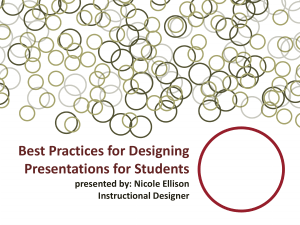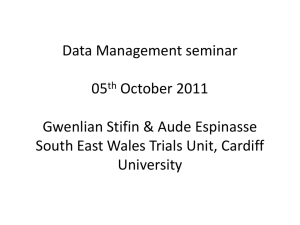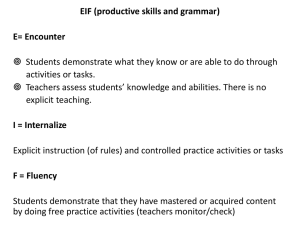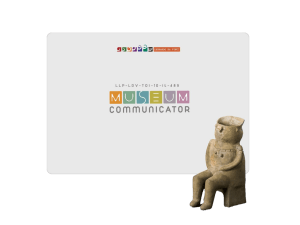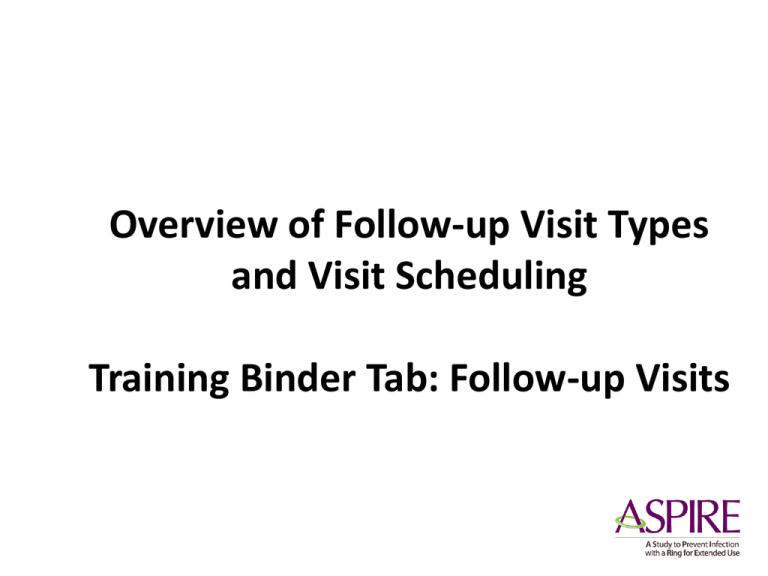
Overview of Follow-up Visit Types
and Visit Scheduling
Training Binder Tab: Follow-up Visits
Scheduling Follow-up Visits
• Ideally, follow-up visits will occur on the target
day, at 28 day intervals from EV date
• A follow-up visit schedule is fixed for each ppt
(based on Enrollment date) and does not change
based on actual visit completion date
• If the visit cannot occur on the target day, it
should be completed as close to the target day as
possible and within the visit window
• Visit windows are continuous, so
each day in follow-up is always in a
window
Target Days and Visit Windows –
A Visual
Each visit window starts 13 days before the target day, and
ends 14 days after
Month 1
Visit Window
-13 Days
+14 Days
Month 2
Visit Window
-13 Days
+14 Days
Month 3
Visit Window
-13 Days
+14 Days
Target
Day
Target
Date
Target
Date
Target Day = 28
Day 56
Day 84
Visit Codes
• Why are they used?
– To indicate at which point in a ppt’s trial participation an event
occurred
• Helpful when reviewing reports and conducting study
analyses
– Knowing that a ppt had a grade 2 AE on 23-SEP-12 doesn’t tell us
much; knowing this is her Month 2 visit does
• Visit Code = Visit Month
– The visit month number is the Visit Code
– Month 1 = Visit Code 01.0
• For the most part, study staff do not have to record a Visit
Code for the SV (97.0) or EV (98.0)
• PUEV and Termination Visit do not have unique visit codes
Visit Codes/Visit Months Example
Visit
Visit Month
Visit Date
Screening
97.0
March 2013
Enrollment
98.0
April 2013
Month 1
01.0
May 2013
Month 2
02.0
1 June 2013
Month 3
03.0
July 2013
Month 4
04.0
August 2013
Month 5
05.0
September 2013
Month 6
06.0
October 2013
Month 7
07.0
November 2013
Month 8
08.0
December 2013
Month 9
09.0
January 2014
Month 10
10.0
February 2014
Month 11
11.0
March 2014
Month 12
12.0
April 2014
Month 13
13.0
May 2014
Month 14
14.0
June 2014
Month 15
15.0
July 2014
Month 16
16.0
August 2014
Visit Calendar Tool
• An Excel file that can be used to create the follow-up
visit schedule/calendar for a ppt with actual dates
– available
@http://www.mtnstopshiv.org/node/3672
• Requires the ppt’s PTID and her full Enrollment Date
• For each required follow-up visit, the target date, date
visit window opens, and date visit window closes are
generated
• Also has blank columns for site to write-in scheduled
and actual visit dates
• For easy reference, print and placed in the ppt’s study
notebook once ppt has enrolled
Visit Calendar Tool – Output (also in PTD)
Missed Visits
• A follow-up visit is missed once the window for the
visit closes and the ppt has not completed any part of
the visit
• Ex.: A participant completes her Month 1 Visit, but
then does not contact the clinic again until she
appears in-person on Day 73
- Since the Month 2 window closed on Day 70, the ppt
has missed her Month 2 visit
Missed Visits
• Missed Visits are documented in the study database
using the Missed Visit CRF
• Do not complete or fax any other CRFs for the missed
visit
– Protocol Deviation Log not completed/required
• The Missed Visit form will let DataFax/SCHARP know
not to expect any other forms for that participant
with that visit code.
Missed Visits Form – New Item 3
Visit Month is
hard-coded with
“.0” at end
Target date is
per ppt calendar
New item 3 =
corrective
action plan
Interim Visits
• An interim visit = a visit/contact that occurs between
required (monthly) follow-up visits
• Required monthly/quarterly/semi-annual visit procedures
are not conducted
– Either not needed (required visit already completed) or not the
purpose of the visit
Ex. A ppt completes Month 6 on the target day and comes
back 5 days later as requested for follow-up of an abnormal
pelvic exam finding
Ex. A ppt completes Month 3 on the target day, and comes
to the clinic 15 days later to report a new symptom
Ex. A ppt phones to report a new AE
Interim Visit Documentation
• Interim Visits are documented like required followup visits, using the Visit Summary CRF
– There is no Interim Visit CRF for ASPIRE
• The interim visit code on the Visit Summary CRF
will let us know it is an interim visit, along with a
“yes” to item 5
• Since we don’t know the reason for the interim
visit or what CRFs were complete, we will need you
to tell us (VS-1 items 5a, 5b)
• Visit Summary CRF items 6 and 7 are left
blank for interim visits
Interim Visit Codes
• If the interim contact results in at least one newly-completed
DataFax CRF, the interim visit is assigned an interim visit code
• Interim visit codes use the box to the right of the decimal
point – assign starting with .1
• For the numbers to the left of the decimal point, use the visit
month of the most recently-required visit, even if the interim
visit date is in the next visit’s window
– The interim visit code will be a number in-between the two visit
months when the interim visit occurred
• Ex.: A ppt has an interim visit 7 days after her Month 6 visit to
draw labs; visit code = 06.1 (in-between Months 6 and 7)
Split Visits
A visit is a split visit when the required visit
procedures are split (done) over 2 or more days
The days must all fall within the visit window; any
required procedures not done within the visit window
are missed procedures
For split visits, only 1 Visit Summary form is
completed, and the Visit Date on this CRF is the date
of the first part of the split visit
All CRFs completed for the split visit are assigned
the same visit code (ex. 12.0)
Can interim visits be split?
Let’s Talk PUEV and Early
Termination…….
PUEV Timing and Required Procedures
• Product Use End Visits will take place at the end of the study,
during the same calendar month for ALL participants
– The PUEV is not when a ppt is permanently discontinued from
product prior to study end
• When PUEVs will happen for all ppts will be determined
based on HIV endpoints
• Possible scenario: in June 2014, it is determined the study
has enough HIV endpoints
– Starting on Aug 1, 2014, each required visit will be conducted as a
PUEV for each ppt
– No special visit code; Visit Month = Visit Code
– No special CRF; will use Visit Summary and mark in item 4/4a that
it is the ppt’s PUEV
Scheduled Study Exit/Termination
• Main purpose is to assess for delayed HIV seroconversion
after product use has ended
• Will occur 4 weeks after the PUEV, at the next regularlyrequired visit
– Example: The ppt’s Month 22 is her PUEV. Month 23 is her
scheduled study exit/term. visit
– No special visit code; Visit Month = Visit Code
– No special CRF; use VS-1 items 4/4a
• HIV-infected ppts will not completed this visit (no need to
assess for delayed seroconversion)
• Since there is no Sample 2 collection, there should not be
any post-termination visits requiring CRFs
Early Termination Visits
• Will occur if a ppt withdraws consent
• If consent withdrawn, complete as many of the
Early Termination visit procedures as possible
– Early Term. = PUEV + Study Exit/Term. Procedures
– Use Early Termination CRF form packet; refer to Early
Termination Visit in Schedule of Forms (Data SSP
Section)
– Mark “early termination” on Visit Summary CRF item 4a
• Ppt should not be contacted for future visits, but do
ask them if they want to be contacted when study
results are available
Follow-up Visit Scenarios for Discussion
Scenario 1
A ppt completes her Enrollment Visit, and comes
back one week later to report a new AE.
Q. What type of visit is this? What visit code is
assigned? What CRF is used to document the visit?
A. This is an interim visit, documented with a
Visit Summary CRF coded as 98.1 (in addition
to any other CRFs).
Follow-up Visit Scenarios for Discussion
Scenario 2
A ppt comes in 12 days before her scheduled Month 8
visit (scheduled for target day). She says she will come
back for her Month 8 visit as scheduled, but needs more
condoms today.
Q. If only condoms are provided, are any CRFs needed for
this visit? If so, which ones and what visit month is used?
A. No CRFs needed since no new CRFs
completed for this visit. Chart note only. Site can
complete Month 8 if they want, but it is better
to wait until the target day if ppt is reliable.
Follow-up Visit Scenarios for Discussion
Scenario 3
A ppt comes in for her Month 13 visit and says
she will complete her visit that day, but will then
withdraw her consent as she no longer wishes
to take part in the study.
Q. What CRFs are completed for the visit?
A. Complete CRFs in the Early Termination
packet. On the Visit Summary, mark that this
is an early termination visit.
Case Report Form Supply
• CRFs will not be shipped from SCHARP; sites are
responsible for CRF supply
• Two options for CRF supply
Print from pdf files located on Atlas
Photocopy from hard-copy CRFs provided in Master Forms
Notebooks (1 per site)
• CRFs are available in visit packets and as a
single PDF form set
Some CRFs (i.e. local-language CRFs) will need to be added
to certain visit packets per packet cover page
• Best option is to print rather than photocopy if
possible; either way, test fax needed
Follow-up Procedures
Visit Types
Follow-up Procedures
Administrative:
Review/Update Locator
Schedule Next Visit
Reimbursement
Behavioral (Counseling):
HIV pre- and post-test
HIV/STI risk reduction
Contraceptive
Adherence
Behavioral (Assessments):
Adherence
Behavioral
Acceptability
Social Harms
ACASI (M3)
Clinical:
Medical/Menst. History
Concomitant Meds
Provide Test Results
Record/Update AEs
Contraceptive provision*
Treatment/referrals*
Physical Exam
Pelvic Exam
Study Product/Supplies:
Condoms
Remove/Collect VR
Provide new VR
Digital Exam (M1)*
VR instructions*
Bottle of Water*
Lab:
Urine:
Pregnancy
Urine culture*
GC and CT
Blood:
HIV Serology
Syphilis Serology*
CBC with platelets
Serum Chemistries
Plasma Storage
Pelvic:
Vaginal Fluid (self)
Herpes Lesion*
Wet mount-Candidiasis*
Wet mount-BV*
Rapid Trichomonas
Vaginal pH
Gram stain
Endocervical swab
Make-up of Missed Procedures
Missed
Quarterly:
Missed
SemiAnnual:
• Physical exam
• CBC with platelets
• Blood chemistries
• Plasma storage
• [Quarterly Procedures]
• Pelvic exam
• Pelvic samples (Trich, pH, gram
stain, endocervical swab)
• NAAT for GC/CT
Make up at next visit
(sched. or interim)
Activity: Making Connections
Activity: Making Connections
Work with the person sitting next to you
Turn to page 34 in your protocols for list of
follow-up study procedures
On your worksheet under each objective, list
what data collection procedure(s) contribute
to each study objective (think endpoints)
HIV Testing-rapids, WB, in some cases RNA and DNA
Record/Update AEs
Medical/Menstrual History
Physical Exam
Pelvic Exam
Blood Tests (hematology,
chemistry)
Urine Tests
Tests for STI/RTIs
Behavioral Assessments (questionnaires, ACASI)
Adherence Assessment (RA-1 CRF)
Vaginal Fluid (self-collection)-PK testing
Plasma Storage-PK testing
Ring Collection (LoA#2)-Biofilms
Plasma Storage-Genotypic HIV Drug resistance
Vaginal Fluid (self-collection)-PK testing
Plasma Storage-PK testing, HIV endpoint confirmation
HIV Testing-rapids, WB, in some cases RNA and DNA
Gram Stain-Nugent scoring
Endocervical Swab-biomarkers
STI/RTI tests (pH, BV, Trich, candidiasis)
Vaginal Fluid (self-collection)-PK testing
Plasma Storage-PK testing
Adherence Measures as outlined previously
HIV testing-rapids, WB, in some cases RNA and
DNA
Visit Checklists
Sequence of Procedures
Modify to maximize efficiency of clinic flow
Very few procedures have required order:
Pelvic Exams
Behavioral Assessments before Counseling
Ideally, vaginal fluid swab with ring still in place
Ring provision toward end of visit (after clinical/lab
assessments)
Recommend pairing Vaginal Ring (VR) removal/insertion
Flexibility is encouraged
Clinic Flow
Why is efficiency important?
What are some strategies that may help
improve clinic flow?
Regular internal reviews of systems is key proactive rather than reactive
Follow-up Visits – Key CRFs
Follow-up Visit CRFs
Quarterly
Monthly
SemiAnnual
Visits
Visits
Visit Summary
Ring Adherence
Monthly Laboratory Results
Family Planning
Ring Collection/Insertion
Follow-up LDMS Specimen Tracking Sheet (non-DataFax)
Behavior Assessment
Quarterly Laboratory Results
Specimen Storage
Abbreviated Physical Exam
Vaginal Practices
Pelvic Exam
Pelvic Exam diagram (non-Data-Fax)
STI Results
Page 219
Monthly CRFs - Visit Summary
Visit Summary CRF
• Completed each time a required follow-up visit is completed
• Captures information on location of visit, prompts for ppt’s use
of PEP or PrEP since last visit (items 2-3 need to be completed
during the visit)
• Documents if this is the ppt’s PUEV, early termination, or
termination visit
• Asks if the visit in an interim visit (will talk about soon), and if
so, which CRFs were newly-completed for the interim visit
• For required visits, asks if any new AE Log pages or Product
Hold/Discontinuation Log pages were completed
• Just yes/no, number of pages completed not collected
• For split visits, complete only 1 Visit Summary CRF on the first
date of that visit
Monthly CRFs – Ring Adherence
• Is not interviewer-administered (read aloud word-for-word), but is
completed based on information obtained from the participant regarding
her ring use
• Completed at all required follow-up visits, even if ppt has been perm d/c
from ring
– If perm d/c, item 1 = no then end of form
– Not completed at interim visits
• Items 2-5 completed based on ppt self-report
– Use ppt’s best estimates – does not have to be precise
• Item 2 – try to include all times the ring has been out, including times
removed and re-inserted by site staff at an interim visit
• Item 5 – mark all reasons reported by the ppt
– Grouped by whether ring was taken out or came out on its own
Monthly CRFs -Family Planning – p.???
• Item 1 – record all methods the ppt reports using
since her last visit
– Update Con Meds Log as needed
• Item 2 – has the ppt had a complete period since
last visit, or is she currently on menses? If yes,
record start date and end date (or ongoing) in
items 2a and 2b.
– If no menses, mark “no” for item 2 and end of form
– If “ongoing” (ppt is currently on menses), mark in 2b
and do not update at later visits
– Just want to capture menses status at time
of visit
Other Monthly CRFs
• Ring Collection and Insertion
– Complete at interim visits as well if a ring was
collected or dispensed
– Will be discussed in detail during product use session
• Monthly Laboratory Results
– pregnancy, HIV rapid, stored plasma for HIV
confirmation; self-collected vaginal swab
• Follow-up LDMS Tracking Sheet
– self-collected vaginal swab; blood for HIV
seroconversion confirmation if a positive rapid HIV
test result at the visit
Quarterly CRFs – Behavior Assessment – p.???
• 2 pages, interviewer-administered, local lang.
• Similar questions as on BBA except no ring
worries questions (asked at Month 3, PUEV)
• Items 1-13 ask about sex partners, sex frequency,
condom use
– Item 14 – is ppt bothered wearing the ring?
– Item 15 – social harm related to study participation in
last 3 months; complete Social Impact Log CRF
Other Quarterly CRFs
• Quarterly Lab results – like Screening Lab Results
CRF
– Hemogram, Differential, Chemistries
• Abbreviated Physical Exam
– Required assessments are same as at Enrollment Visit
• Specimen Storage (p.239)
– quarterly plasma, semi-annual pelvic gram stain and
endocervical swab; used vaginal ring for storage
• Follow-up LDMS Specimen Tracking Sheet
Additional CRFs for Month 3
• Follow-up ACASI Tracking
– Complete when ACASI done; required at Month 3 and at
PUEV or at perm product d/c; item 2 = use to document
any problems/issues with the questionnaire
• Ring Worries
–
–
–
–
Completed at Month 3 and PUEV only
Interviewer-administered, in local language
Item 1 – how worried about wearing the ring every day
Item 2 – specific worries ppt may be having; read each
aloud and ask for a yes/no response
– Item 3 – completed only at PUEV/early termination; ppt’s
thought on which product she was using (active or
placebo)
Semi-Annual CRFs - Vaginal Practices
• Completed at same visits as pelvic exams
– Semi-annual, PUEV/early termination
• Interviewer-administered, local language
• Similar questions as Baseline Vaginal Practices
– Items 4 and 5
– Item 5d (whether ppt has inserted fingers to clean or insert
something the past 3 months does not include Vaginal Ring
insertion
• Items 1-3 involve menses and ring use
– Was ring worn during menses (even for just a part of menses)
– How did the ppt like wearing the ring during menses
Semi-Annual CRFs cont’d
• Pelvic Exam (p.249)
– Similar to Screening Pelvic Exam CRF
• STI Test Results
– Similar to Screening STI Test Results
Any Questions At This Time?



